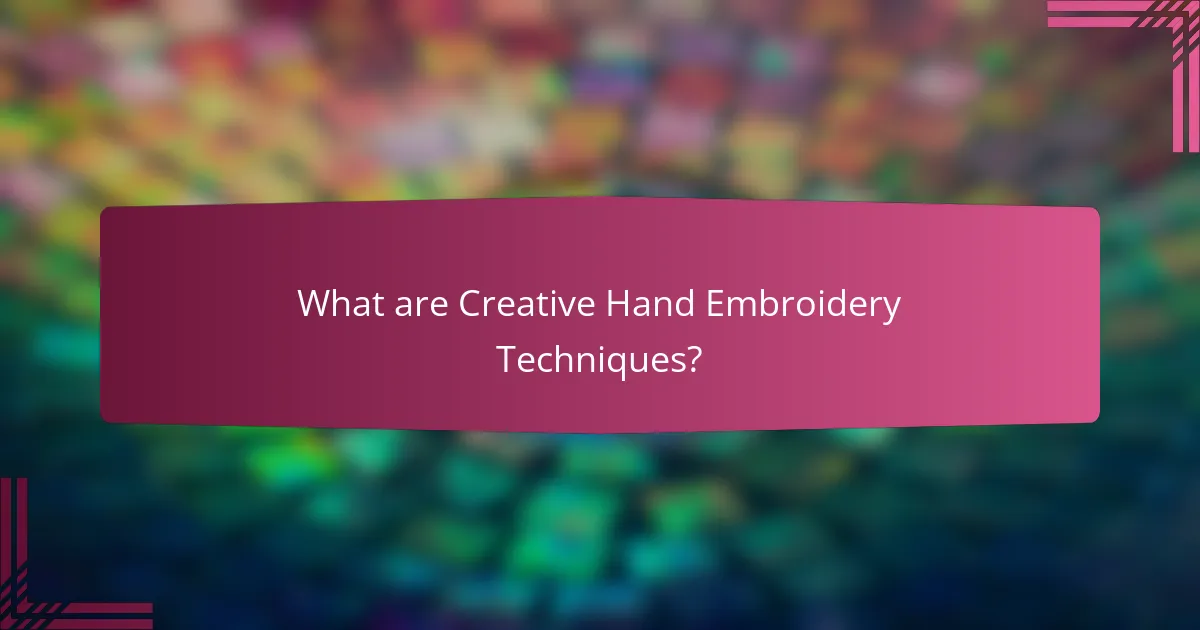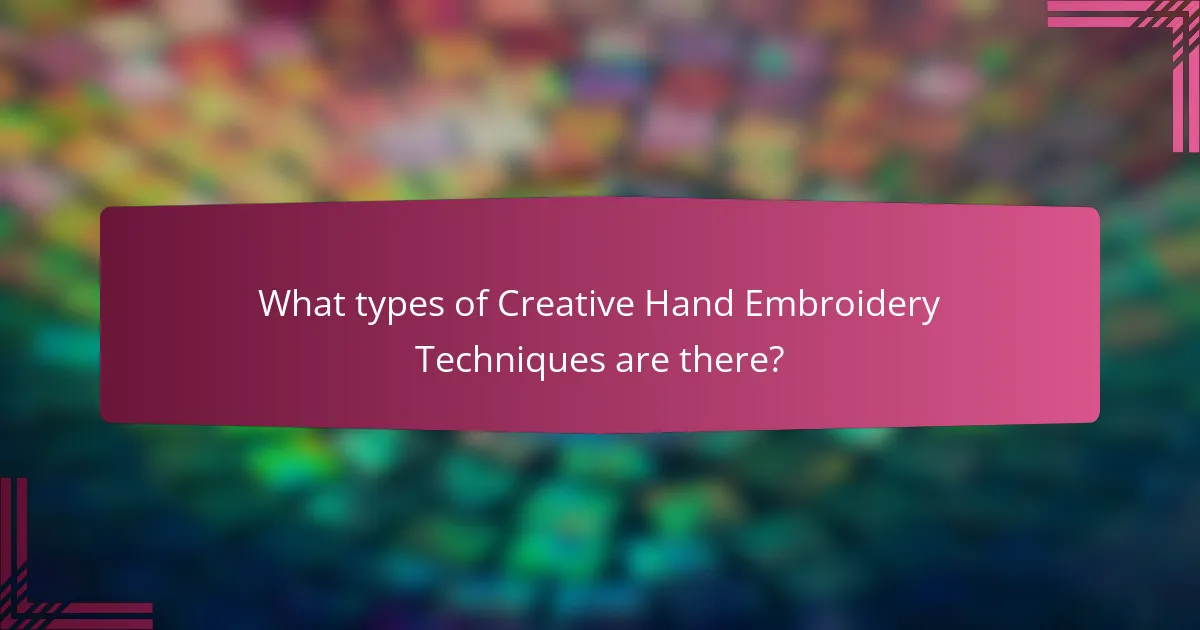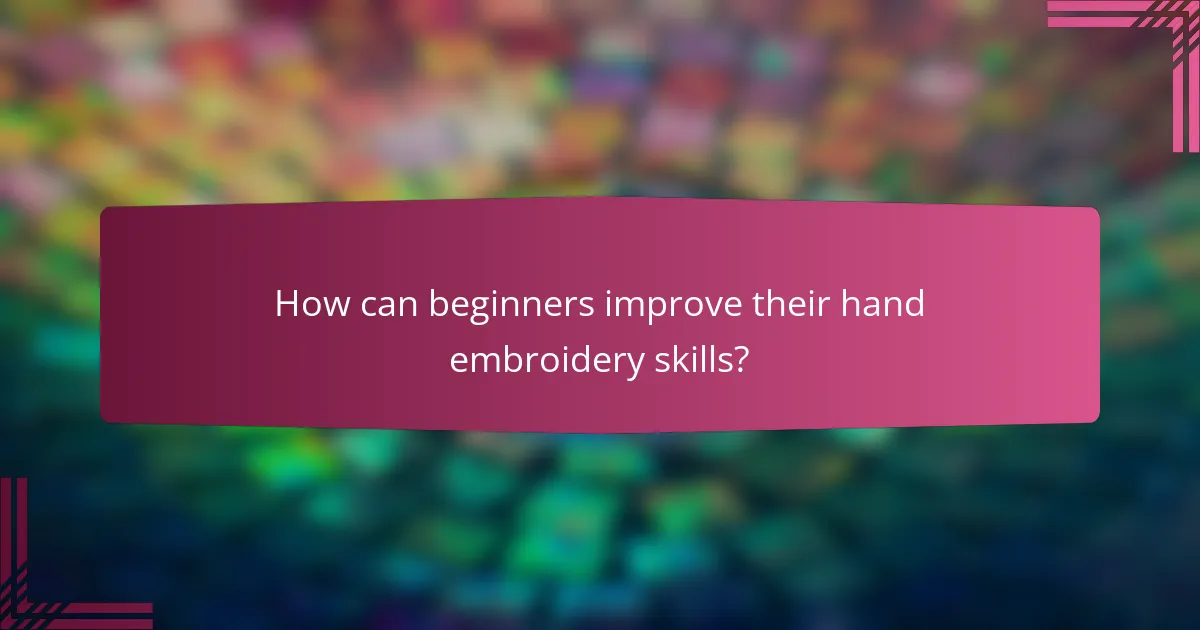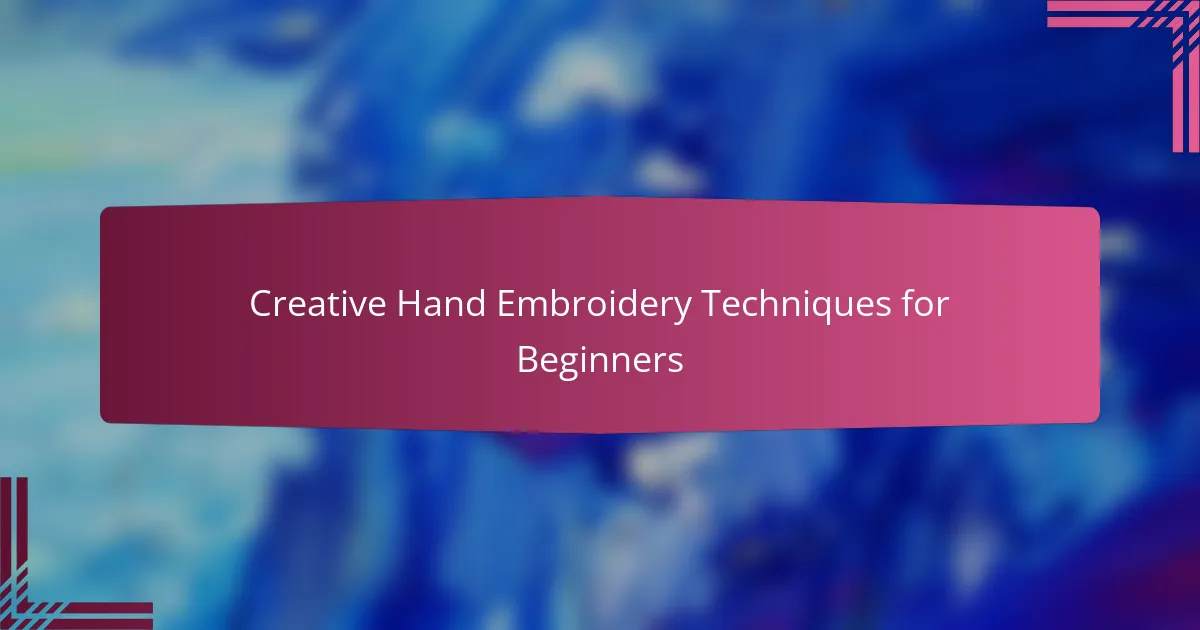
What are Creative Hand Embroidery Techniques?
Creative hand embroidery techniques involve various methods and styles used to embellish fabric with needle and thread. These techniques can include basic stitches like backstitch and satin stitch, as well as more intricate methods such as French knots and chain stitch. Each technique allows for unique textures and designs. For example, the satin stitch fills shapes with smooth, flat threads, while French knots create raised dots for added dimension. These methods can be combined to create detailed patterns. Hand embroidery has historical roots, with evidence of its practice dating back to ancient civilizations. The versatility of these techniques makes them suitable for beginners aiming to explore creativity in textile art.
How can beginners get started with hand embroidery techniques?
Beginners can start with hand embroidery techniques by gathering essential supplies. Key supplies include embroidery floss, needles, fabric, and scissors. Next, beginners should learn basic stitches like the running stitch and backstitch. Practicing these stitches on scrap fabric helps build confidence. Following online tutorials or books can provide visual guidance. Joining local or online embroidery groups can offer support and inspiration. Setting small projects, like simple designs or monograms, helps in skill development. Regular practice will enhance proficiency in hand embroidery techniques.
What tools and materials are essential for beginners?
Essential tools and materials for beginners in hand embroidery include embroidery hoops, needles, and thread. An embroidery hoop holds fabric taut, making stitching easier and more precise. Needles should be sharp and appropriate for the thread type and fabric weight. Commonly used embroidery thread includes floss, which is made of six strands that can be separated for various thicknesses. Fabric choices often include cotton or linen, as they are easy to work with. Scissors are necessary for cutting threads and trimming fabric edges. A marking pen or chalk helps transfer designs onto fabric. Finally, a needle threader can assist in threading needles easily. These items provide a solid foundation for starting hand embroidery projects.
What are the basic stitches every beginner should learn?
The basic stitches every beginner should learn are the straight stitch, back stitch, running stitch, and whip stitch. The straight stitch is the most fundamental stitch used for outlining and detailing. The back stitch creates a solid line by stitching backward and forward. The running stitch is a simple stitch that forms a dashed line, useful for gathering fabric. The whip stitch is used for sewing two pieces of fabric together at the edges. Mastering these stitches provides a solid foundation for various embroidery projects.
Why is hand embroidery a popular creative outlet?
Hand embroidery is a popular creative outlet due to its accessibility and versatility. It requires minimal materials, making it easy for beginners to start. Many people find it relaxing and meditative, providing a break from daily stress. The variety of stitches and techniques allows for endless creativity. Hand embroidery can be personalized, making each piece unique. Social media platforms showcase diverse embroidery projects, inspiring others to join the craft. Workshops and online tutorials further promote its popularity. According to a survey by the Craft and Hobby Association, 60% of crafters engage in embroidery as a form of creative expression.
What benefits does hand embroidery offer for mental well-being?
Hand embroidery offers several benefits for mental well-being. Engaging in this craft promotes relaxation and mindfulness. The repetitive motions involved can reduce anxiety and stress levels. Studies show that creative activities like embroidery can boost mood and enhance feelings of accomplishment. Additionally, completing a project provides a sense of achievement. This can improve self-esteem and foster a positive outlook. Furthermore, hand embroidery can serve as a form of meditation, allowing individuals to focus on the present moment. Engaging in such activities has been linked to improved cognitive function and emotional resilience.
How does hand embroidery foster creativity and self-expression?
Hand embroidery fosters creativity and self-expression by allowing individuals to create unique designs. It provides a medium for personal storytelling through visual art. Each stitch can represent different emotions or experiences. The choice of colors, patterns, and techniques reflects individual preferences. This form of art encourages experimentation and innovation. Studies show that engaging in creative activities reduces stress and enhances well-being. According to a report by the American Psychological Association, crafting can improve mood and cognitive function. Overall, hand embroidery serves as a powerful outlet for personal expression and creativity.

What types of Creative Hand Embroidery Techniques are there?
There are several types of creative hand embroidery techniques. Common techniques include cross-stitch, satin stitch, and backstitch. Cross-stitch involves creating X-shaped stitches to form a pattern. Satin stitch fills shapes with smooth, flat stitches. Backstitch provides a solid outline by stitching backward along a line. Other techniques include French knots, which create textured dots, and chain stitch, known for its looped appearance. Each technique varies in complexity and application. Beginners can start with simpler stitches before progressing to more intricate methods.
How do different techniques vary in complexity?
Different hand embroidery techniques vary in complexity based on their stitch types and required skills. Basic techniques, such as running stitch and backstitch, are simple and suitable for beginners. Intermediate techniques, like satin stitch and chain stitch, require more precision and practice. Advanced techniques, including French knots and bullion knots, demand higher skill levels and intricate handling. The complexity can also be influenced by the design and layering involved in the project. For instance, a simple floral design may use basic stitches, while a detailed landscape may incorporate multiple advanced techniques. Understanding these variations helps beginners choose appropriate projects that match their skill levels.
What are some beginner-friendly embroidery techniques?
Beginner-friendly embroidery techniques include the backstitch, running stitch, and satin stitch. The backstitch creates a solid line, ideal for outlining shapes. The running stitch is simple and used for straight lines or curves. The satin stitch fills in shapes with a smooth finish. These techniques require minimal tools, making them accessible for beginners. Each technique builds foundational skills for more complex embroidery. Mastering these basics can lead to more intricate designs.
How do advanced techniques differ from beginner techniques?
Advanced techniques in hand embroidery involve more complex stitches and patterns than beginner techniques. Beginners typically focus on basic stitches like running stitch and backstitch. Advanced techniques may include intricate stitches such as French knots or satin stitch. These advanced stitches allow for greater detail and texture in designs. Additionally, advanced techniques often require a deeper understanding of color theory and fabric types. This knowledge enhances the overall aesthetic of the embroidery. Advanced embroiderers may also experiment with layering and mixed media. This creativity leads to unique and personalized pieces.
What styles can be achieved with hand embroidery?
Hand embroidery can achieve various styles, including traditional, contemporary, and decorative. Traditional styles often feature floral motifs and intricate patterns, reflecting cultural heritage. Contemporary styles may incorporate abstract designs and innovative techniques. Decorative styles focus on embellishing garments and home textiles with unique stitches. Each style utilizes different stitches, colors, and materials to create distinct visual effects. Popular techniques include cross-stitch, satin stitch, and chain stitch. These styles allow for personal expression and creativity in embroidery projects.
How can beginners incorporate different styles into their projects?
Beginners can incorporate different styles into their hand embroidery projects by exploring various techniques and patterns. They should start by researching different embroidery styles such as traditional, modern, or abstract. Practicing basic stitches like satin, backstitch, and French knots helps build foundational skills.
Using a variety of thread types and colors can enhance the visual appeal. Beginners can also experiment with different fabrics, such as linen or cotton, to see how they affect the final look. Additionally, following online tutorials or joining embroidery communities provides valuable insights and inspiration.
Incorporating elements from multiple styles can lead to unique, personalized projects. This approach fosters creativity and allows beginners to develop their artistic voice.
What are some popular themes in hand embroidery?
Popular themes in hand embroidery include floral designs, animals, and geometric patterns. Floral themes often feature various flowers and plants, showcasing vibrant colors and intricate details. Animal themes can range from realistic portrayals to whimsical interpretations. Geometric patterns focus on shapes and symmetry, providing a modern aesthetic. Other themes include nature scenes, cultural motifs, and personalized monograms. Each theme allows for creativity and individual expression, making hand embroidery a versatile craft.

How can beginners improve their hand embroidery skills?
Beginners can improve their hand embroidery skills by practicing regularly. Consistent practice helps develop muscle memory and precision. Learning basic stitches is essential for building a strong foundation. Popular stitches include the backstitch, satin stitch, and French knot. Following online tutorials or taking classes can provide structured guidance. Engaging with embroidery communities can offer support and inspiration. Experimenting with different fabrics and threads enhances creativity. Keeping a dedicated embroidery journal helps track progress and techniques learned.
What resources are available for learning hand embroidery techniques?
Books on hand embroidery techniques are widely available. Popular titles include “Embroidery Basics” by Jessica Marquez and “The Embroidery Book” by the editors of Stitch. Online platforms offer courses and tutorials. Websites like Skillshare and Udemy provide structured learning paths. YouTube hosts numerous channels dedicated to embroidery. Channels such as “The Spruce Crafts” and “Handiwork” feature step-by-step videos. Local craft stores often hold workshops. These in-person classes allow hands-on experience. Additionally, social media groups foster community learning. Platforms like Facebook and Instagram have active embroidery communities sharing tips and techniques.
How can online tutorials enhance the learning experience?
Online tutorials enhance the learning experience by providing accessible and flexible learning opportunities. They allow learners to engage with content at their own pace. This adaptability caters to different learning styles and schedules. Online tutorials often include visual aids, which help clarify complex techniques. For example, video demonstrations show hand movements in real-time. This visual representation can improve understanding and retention of skills. Additionally, many platforms offer interactive features, such as quizzes and forums. These features encourage active participation and foster a sense of community among learners. Overall, online tutorials make learning more engaging and effective for beginners in creative hand embroidery techniques.
What role do books and workshops play in skill development?
Books and workshops are essential for skill development in creative hand embroidery. They provide structured learning and practical experience. Books offer comprehensive guides, techniques, and inspiration for beginners. They often include step-by-step instructions and illustrations. Workshops facilitate hands-on practice and immediate feedback from instructors. This interactive environment enhances understanding and retention of skills. Research shows that active engagement in learning improves skill acquisition significantly. According to a study by the National Training Laboratory, people retain 75% of what they practice actively. Thus, both resources are vital for effective skill development in hand embroidery.
What are some common mistakes beginners make in hand embroidery?
Beginners in hand embroidery often make several common mistakes. One mistake is using the wrong needle type for the fabric. Using a needle that is too thick can damage delicate fabrics. Another mistake is not securing the thread properly. This can lead to unraveling and loose stitches.
Additionally, beginners may neglect to use an embroidery hoop. Without a hoop, the fabric can shift, causing uneven stitches. Some beginners also tend to pull the thread too tightly. This can result in puckering on the fabric surface.
Lastly, beginners often skip practicing basic stitches. Mastering foundational stitches is essential for more complex designs. These mistakes can hinder the quality of the finished embroidery project.
How can these mistakes be avoided?
To avoid mistakes in creative hand embroidery, beginners should practice proper planning and preparation. Start by selecting the right fabric and thread for the project. Using high-quality materials reduces the likelihood of issues. Additionally, beginners should always use sharp, appropriate needles for their chosen thread and fabric. This ensures smoother stitching and less fraying.
Following a clear and detailed pattern is crucial. Beginners should take time to read instructions thoroughly before starting. This helps in understanding the steps involved and prevents confusion. Regularly checking the tension while stitching also helps in avoiding puckering and uneven stitches.
Lastly, taking breaks during the embroidery process can prevent fatigue-related errors. A fresh perspective often leads to better results. By adhering to these practices, beginners can significantly minimize mistakes in their embroidery projects.
What troubleshooting tips can help beginners overcome challenges?
Beginner embroiderers can overcome challenges by following specific troubleshooting tips. First, ensure that the embroidery thread is correctly threaded through the needle. Incorrect threading can lead to skipped stitches. Second, check the tension settings on the sewing machine if using one. Improper tension can cause puckering or loose stitches. Third, use an appropriate needle size for the fabric type. A mismatched needle can damage the fabric and affect stitch quality. Fourth, practice consistent stitch length for uniformity. Inconsistent lengths can disrupt the design’s appearance. Fifth, keep the fabric taut in the hoop to avoid loose areas. A loose fabric can lead to distortion in the design. Lastly, refer to online tutorials for visual guidance. Many resources provide step-by-step solutions for common issues.
What are the best practices for successful hand embroidery projects?
Successful hand embroidery projects require careful planning and execution. Start with selecting high-quality materials. Use good fabric, threads, and needles to ensure durability and ease of work. Prepare your design clearly. Transfer it onto the fabric accurately to guide your stitching. Choose appropriate stitches for your design. Familiarize yourself with various stitches to achieve different textures and effects. Maintain consistent tension while stitching. This ensures uniformity in your work and prevents puckering. Keep your workspace organized. An uncluttered area reduces frustration and increases efficiency. Practice regularly to improve your skills. Consistent practice leads to better technique and confidence in your projects. Finally, finish your work properly. Secure threads and clean up any excess fabric for a polished look.
Creative hand embroidery techniques encompass various methods used to embellish fabric with needle and thread, including basic stitches like backstitch and satin stitch, as well as intricate methods such as French knots and chain stitch. This article provides essential guidance for beginners, detailing the necessary tools and materials, basic stitches to master, and popular themes in hand embroidery. It also highlights the mental well-being benefits of this craft, the importance of consistent practice, and resources for skill development, such as books and online tutorials. Additionally, it addresses common mistakes beginners make and offers troubleshooting tips to enhance their embroidery projects.
